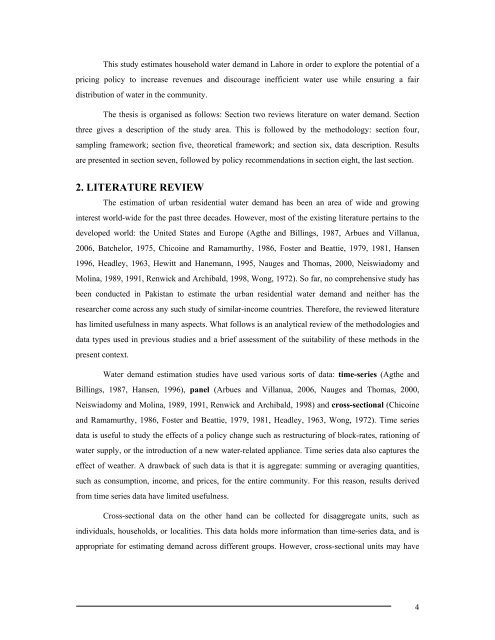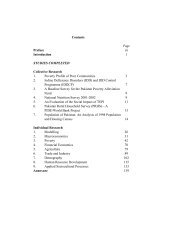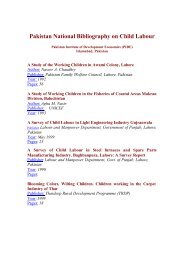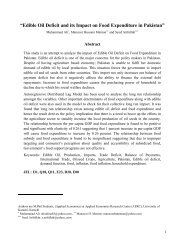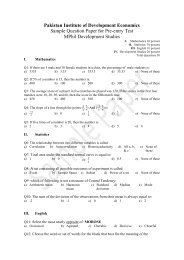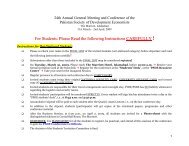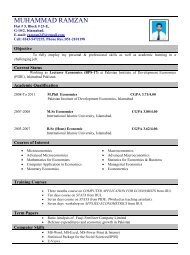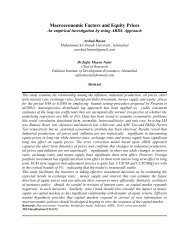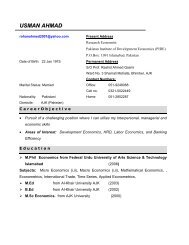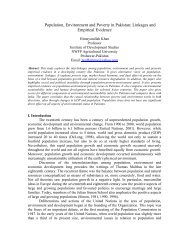Pricing Policy Effectiveness is Domestic Water Demand Management
Pricing Policy Effectiveness is Domestic Water Demand Management
Pricing Policy Effectiveness is Domestic Water Demand Management
Create successful ePaper yourself
Turn your PDF publications into a flip-book with our unique Google optimized e-Paper software.
Th<strong>is</strong> study estimates household water demand in Lahore in order to explore the potential of a<br />
pricing policy to increase revenues and d<strong>is</strong>courage inefficient water use while ensuring a fair<br />
d<strong>is</strong>tribution of water in the community.<br />
The thes<strong>is</strong> <strong>is</strong> organ<strong>is</strong>ed as follows: Section two reviews literature on water demand. Section<br />
three gives a description of the study area. Th<strong>is</strong> <strong>is</strong> followed by the methodology: section four,<br />
sampling framework; section five, theoretical framework; and section six, data description. Results<br />
are presented in section seven, followed by policy recommendations in section eight, the last section.<br />
2. LITERATURE REVIEW<br />
The estimation of urban residential water demand has been an area of wide and growing<br />
interest world-wide for the past three decades. However, most of the ex<strong>is</strong>ting literature pertains to the<br />
developed world: the United States and Europe (Agthe and Billings, 1987, Arbues and Villanua,<br />
2006, Batchelor, 1975, Chicoine and Ramamurthy, 1986, Foster and Beattie, 1979, 1981, Hansen<br />
1996, Headley, 1963, Hewitt and Hanemann, 1995, Nauges and Thomas, 2000, Ne<strong>is</strong>wiadomy and<br />
Molina, 1989, 1991, Renwick and Archibald, 1998, Wong, 1972). So far, no comprehensive study has<br />
been conducted in Pak<strong>is</strong>tan to estimate the urban residential water demand and neither has the<br />
researcher come across any such study of similar-income countries. Therefore, the reviewed literature<br />
has limited usefulness in many aspects. What follows <strong>is</strong> an analytical review of the methodologies and<br />
data types used in previous studies and a brief assessment of the suitability of these methods in the<br />
present context.<br />
<strong>Water</strong> demand estimation studies have used various sorts of data: time-series (Agthe and<br />
Billings, 1987, Hansen, 1996), panel (Arbues and Villanua, 2006, Nauges and Thomas, 2000,<br />
Ne<strong>is</strong>wiadomy and Molina, 1989, 1991, Renwick and Archibald, 1998) and cross-sectional (Chicoine<br />
and Ramamurthy, 1986, Foster and Beattie, 1979, 1981, Headley, 1963, Wong, 1972). Time series<br />
data <strong>is</strong> useful to study the effects of a policy change such as restructuring of block-rates, rationing of<br />
water supply, or the introduction of a new water-related appliance. Time series data also captures the<br />
effect of weather. A drawback of such data <strong>is</strong> that it <strong>is</strong> aggregate: summing or averaging quantities,<br />
such as consumption, income, and prices, for the entire community. For th<strong>is</strong> reason, results derived<br />
from time series data have limited usefulness.<br />
Cross-sectional data on the other hand can be collected for d<strong>is</strong>aggregate units, such as<br />
individuals, households, or localities. Th<strong>is</strong> data holds more information than time-series data, and <strong>is</strong><br />
appropriate for estimating demand across different groups. However, cross-sectional units may have<br />
4


